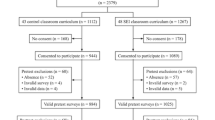Abstract
Controversies exist regarding the effects of sex education in the schools and informal sex education obtained from parents, peers, the mass media, and other sources. Similarly, there is widespread interest in premarital sexual behavior, especially its determinants. This study presents several issues reflecting these concerns which have been the subject of much speculation but which have received little attention by researchers. The purpose of this study was to investigate — through the use of respondent reports — how formal and informal sex education influences premarital sexual behavior during college. A national probability sample of 1177 college students was studied using face-to-face interviews with approximately equal numbers of males and females. These interviews, which were conducted for the Institute for Sex Research, included questions about past and present sexual involvement and other attitudinal, behavioral, and background variables. Accordingly, the data about sexual behavior and attitudes are based on the interviewees' self-reports. Indices were created which operationalized independent variables such as familial sexual conservatism, exposure to eroticism, perceived sex knowledge, and sexual exposure and assault during childhood and adolescence. Individual items reflecting childhood sex play, masturbation, current religiosity, religiosity while growing up, social class, sources of sex information, sex education in classrooms, and high school and college dating were used. The dependent variable, premarital sociosexual involvement, is a composite measure of incidence and prevalence of premarital heterosexual involvement which meets Guttman scaling criteria. An Automatic Interaction Detector analysis was used to determine the relative influences of reported sexualization variables on premarital sexual behavior. Major findings can be summarized as follows: Heterosexual behavior progresses in stepwise fashion from elementary to advanced levels of involvement, with each level representing a threshold. Reports of current influences and pressures explain more variance in premarital sexual behavior than reports of past informal sexualization influences, which, in turn, explain more variance than reported formal sex-educating experiences. Limited success was reported with the use of a four-stage AID analysis which attempted to ascertain whether variables represented in later stages of the sexualization process “mask” the effects of variables in earlier stages and whether a developmental process can be identified. It may be concluded that these data do not support the belief that exposure to sexuality through formalsex education influences premarital sexual behavior. Informalsex education has significantly more impact on premarital sexual behavior, but there are indications that pressures and experiences confronting young people in a given dating or peer group situation take precedence over all past sexual socialization influences.
Similar content being viewed by others
References
Carns, D. E. (1969). Religiosity, premarital sexuality and the American college student: An empirical study. Unpublished doctoral dissertation, Indiana University, Bloomington.
Christensen, H. T., and Carpenter, G. R. (1962). Value-behavior discrepancies regarding premarital coitus in three western cultures.Am. Sociol. Rev. 27: 66–74.
Christensen, H. T., and Gregg, C. F. (1970). Changing sex norms in America and Scandinavia.J. Marriage Family 32: 616–627.
Clayton, R. R. (1969). Religious orthodoxy and premarital sex.Soc. Forces 47: 469–474.
Commission on Obscenity and Pornography (1971).Technical Reports of the Commission on Obscenity and Pornography, Vols. 1–10, Government Printing Office, Washington, D.C.
Davis, K. E. (1970). Sex on the campus: Is there a revolution?Medical Aspects of Human Sexuality, winter.
Edwards, A. L. (1957).Techniques of Attitude Scale Construction Appleton-Century-Crofts, New York.
Ehrman, W. W. (1959).Premarital Dating Behavior Holt, Rinehart and Winston, New York.
Goodenough, W. H. (1944). A technique for scale analysis.Educ. Psychol. Meas. 4: 179–190.
Hatch, G. (1968). Patterns of affection in dating approved by B.D.S. students. Unpublished master's thesis, Brigham Young University, Provo, Utah.
Heltsley, M. E., and Broderick, C. B. (1969). Religiosity and premarital sexual permissiveness: A re-examination of Reiss' traditionalism proposition.J. Marriage Family 31: 441–443.
Hunt, M. (1974).Sexual Behavior in the Seventies Playboy Press, Chicago.
Kaats, G. R., and Davis, K. E. (1970). The dynamics of sexual behavior of college students.J. Marriage Family 32: 390–399.
Kinsey, A. C., Pomeroy, W., and Martin, C. (1948).Sexual Behavior in the Human Male Saunders, Philadelphia.
Kinsey, A. C., Pomeroy, W., Martin, C., and Gebhard, P. (1953).Sexual Behavior in the Human Female Saunders, Philadelphia.
Klassen, A., and Levitt, E. (1970). National sex survey. Unpublished.
Luckey, E. B., and Nass, G. D. (1969). A comparison of sexual attitudes and behavior in an international sample.J. Marriage Family 31: 364–379.
Nie, N. H., Bent, D. H., and Hull, C. H. (1970).Statistical Package for the Social Sciences McGraw-Hill, New York.
Reiss, I. (1967).The Social Context of Premarital Sexual Permissiveness Holt, New York.
Robinson, I. E., King, K., and Balswick, J. O. (1972). The premarital sexual revolution among college females.Family Coordinator 21: 189–194.
Ruppel, H. J., Jr. (1970). Religiosity and premarital sexual permissiveness: A response to the Reiss-Geltsley and Broderick debate.J. Marriage Family 32: 647–655.
Schofield, M. (1965).The Sexual Behavior of Young People Little, Brown, Boston.
Sonquist, J. A., and Morgan, J. N. (1964).The Detection of Interaction Effects Survey Research Center, Monograph No. 35, Ann Arbor, Mich.
Sorensen, R. (1973).Adolescent Sexuality in Contemporary America World Publishing, Cleveland.
Spanier, G. B. (1973). Sexual socialization and premarital sexual behavior: An empirical investigation of the impact of formal and informal sex education. Unpublished doctoral dissertation, Northwestern University, Evanston, Ill.
Zelnik, M., and Kantner, J. F. (1972). Sexuality, contraception and pregnancy among unwed females in the United States. InDemographic and Social Aspects of Population Growth, res. vol. 1 of the Commission on Population Growth and the American Future, Government Printing Office, Washington, D.C., pp. 355–374.
Author information
Authors and Affiliations
Additional information
The original study was funded by NICHD Grant PHS RO1 HD 02257. The secondary analysis for this article was supported by a grant from the Woodrow Wilson Foundation.
Rights and permissions
About this article
Cite this article
Spanier, G.B. Formal and informal sex education as determinants of premarital sexual behavior. Arch Sex Behav 5, 39–67 (1976). https://doi.org/10.1007/BF01542239
Issue Date:
DOI: https://doi.org/10.1007/BF01542239




